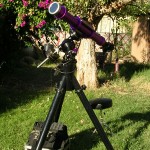About a dozen times a century Mercury passes in front of the Sun as seen from Earth. The event is observable with a modest telescope and a solar filter, Mercury can be seen as a small black dot crossing the surface of the Sun. If half of those happen when the sun is below your horizon the average person will have the chance to observe five or six in a lifetime. Since the next opportunity will not occur until May 9th, 2016 I didn’t want to miss this one!

Considering that Mercury never gets very far from the Sun means that most of the time you can observe Mercury it is low on the horizon and is typically seen through a great deal of atmospheric distortion. A transit is one exception to this, during a transit mercury is a sharp disk, very different from the multicolor jello ball that is usually seen.
The 2006 Transit was well timed for observation across western North America, starting just after noontime and ending at 5:09pm MST. This put the Sun high in the sky for all but the last part of the event. Our weather cooperated as well, delivering a cloudless blue sky the entire day in place of the clouds that had been forecast. The air was reasonably steady as well allowing good photographic and observing conditions.
I took advantage of the weather and photographed almost the entire transit, all but the very end when the sun sank below the trees in my neighborhood. I used the Canon 20Da and setup a timer to shoot every 5min. The only issue was the inability to do a polar alignment on the mount when setting up in the middle of the day. The result was I had to manually guide the scope every 10-15 min to keep the sun centered.
I got plenty of good photographic material, enough for a few single photos as well as an animation of the transit. A transit is an impressive demonstration of the scale and arrangement of our solar system. Not hard to visualize the reality of those textbook drawings of planetary orbits after you have had such an opportunity to see the real thing.
No complaints on my second Mercury transit.


